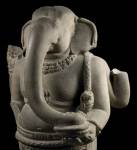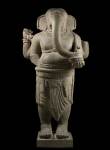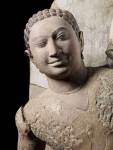‘Beyond India, before China’ was how early geographers summed up the large chunk of the world that today comprises Myanmar (Burma), Thailand, Laos, Vietnam, Cambodia, Malaysia and Indonesia. Little was known about the region then, and in recent centuries its renown has rested on colonialism and devastating wars rather than the great art of its early kingdoms.
Most of these kingdoms, which flourished in the 5th to 8th centuries, failed and were forgotten when trading routes changed. Then, about 130 years ago, archaeologists quietly starting digging, finding stone carvings of the highest quality that testify to sophisticated cultures, large urban populations and royal patronage.
Now the Metropolitan Museum of Art, New York, has staged a landmark show, ‘Lost Kingdoms’. For the first time, a major loan show of these sculptures – many of them masterpieces, many of them monumental in size – turns the spotlight on seven kingdoms ranging from Burma’s Pyu to Indonesia’s Srivijaya, which was a regional centre for Buddhist learning with key connections to India’s major monasteries including Nalanda, Sarnath and Amaravati.
The Chinese had plenty of trading and monastic relations with the region, but in terms of culture this is, above all, a tale of Indian influence. Indian monks, sailors and merchants braved the Bay of Bengal waves to introduce the philosophies, rituals and artistic blueprints of Buddhism and Hinduism to Southeast Asia. Each kingdom, it seems, mixed this cultural basket of goodies with existing animistic beliefs to develop their own sculptural styles, their own cults. One was Ganesh as the powerful and dangerous Ganapati (represented here by three dynamic sculptures); another was Vishnu’s final avatar Kalkin (a monumental, sleek horse-headed figure from South Cambodia is on display); still another is Krishna raising Mount Govardhan (as seen in the almost Hellenistic, over life-sized, humanist figure found in a rock-cut cave at Phnom Da in 1944).
John Guy, curator of South and Southeast Asian art at the Met, has studied the area for decades and even worked his trowel at some sites. Combining his on-site experiences and his museum contacts he has gathered, quite simply, the best of the best. ‘The Indian art world is in for a shock’, he says with glee. ‘There are things here that survived in this region but not in India.’
Khin Ba Relic Chamber Cover. Lent by Thiri Khittaya (Śrī Ksetra) Archaeological Museum, Hmawza, Myanmar. Photo: Thierry Ollivier

Sources vary widely. The great carved stone closing a relic chamber of a 6th century stupa found at Burma’s Sri Ksetra site by Charles Duroiselle in 1926–7, complete with its glittering treasures, is considered by Guy to be ‘the most remarkable discovery of early relic Buddhist finds in the Buddhist world’. They leave their site museum for the first time. Paris’s more accessible Musée Guimet has lent a dozen pieces that include a ravishing, life-sized sandstone Bodhisattva Avalokiteshvara made in the 7th century, found in a muddy canal in Southern Vietnam in 1919. Guy deems it ‘arguably the most beautiful image of the Buddhist embodiment of compassion from all of Southeast Asia’.
This could be overwhelming, especially for the non-specialist. But it is not, thanks to the show’s designer Michael Langley and the deceptively simple-looking installation. The groupings of objects offer fascinating stylistic comparisons – one includes four life-sized seated Buddhas that come from Myanmar, Thailand, Cambodia and Vietnam. Gentle spotlighting washes over each sculpture to enliven the superb carving and imitate the controlled light in their original temple settings. In addition to this, the catalogue (written by a string of specialists) is a fascinating read for both scholars and amateurs.
It will be hard to cap this: it may well be the exhibition of the year.
‘Lost Kingdoms: Hindu-Buddhist Sculpture of Early Southeast Asia, 5th to 8th Century’ is at the Metropolitan Museum of Art, New York, until 27 July.
A symposium, ‘New Perspectives on Hindu-Buddhist Sculpture in Southeast Asia, 5th to 8th Century’ will be held at the Metropolitan Museum of Art (free with museum admission) on 17 May.







